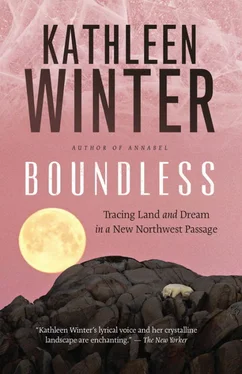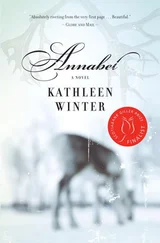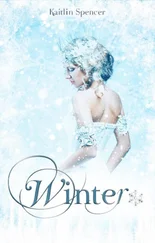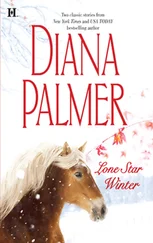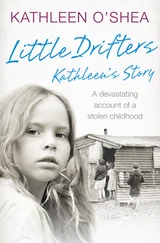“I can’t begin to tell you,” Nathan told everyone, “how cool it is to be doing this trip with you folks. It’s one thing to finish your own business: another thing to finish someone else’s.” And then he began singing his father’s song.
Throughout the voyage Nathan would sing in many voices: his father’s voice came through him, and that took a certain kind of strength that made him a conduit. But he has his own voice as well, which is a more modern voice, more complex and nuanced and imbued with Nathan’s own esoteric psychology. It is strangely psychic and muscular at the same time, and always linking ancient and future worlds.
As night fell, in a shipboard ceremony to welcome us to the North, Aaju held the body of a red-throated loon, hollowed and filled with tinder-dry lichen.
“It’s very flammable,” Aaju said, coaxing a piece of lichen out of the loon. She lit a spark with flint stones and used a stick to carry the flame to the lichen fragment. She then transferred flame from the lichen to a traditional stone lamp whose wick, she told us, had been twisted out of willow cotton and seal fat.
“Sometimes,” she said, “we use whale or caribou fat.” She was drinking coffee out of a Starbucks travel mug. “The lamp, when it is lit, can melt snow for a whole pot of water.” I noticed then that the traditional Inuit patterns tattooed on each of Aaju’s hands imitated the flames of the stone lamp she was holding. She bears tattoos on her forehead, as well; many Inuit women, I’ve learned, are reintroducing these body markings after generations of cultural suppression.
Next, Bernadette told us about Aaju’s clothing.
“ Tuilli ,” she explained, referring to Aaju’s anorak, or inner parka, “means ‘most practical garment.’ See how it’s designed with a V on its back? That’s to signify the beak of a ptarmigan. It shows respect for that bird. The pointed hood means the caribou’s tongue, and the shape of each of Aaju’s boots resembles the head of a seal because the seal gives us fat for the lamp, and it gives its skin to keep our feet, hands, and bodies warm.”
All electric lights were out in the lounge where the ceremony took place, and the seal-oil lamp gave off a glow that did not blare or rise beyond a gentle light, yet somehow lit every attentive face in the room. The flame burned along the wick of twisted tundra plants like a line of glowing fluid. Aaju cut raw seal heart with her ulu’s curved blade and shared it. I ate a piece, sweet and cold, dense and bloody. Beyond the orange light I saw the blue Arctic night press against the windows. I moved out into it.
Many of the other passengers had gone to bed early, but a few lingered outside in a blue glow I’d seen nowhere else. The deck was a marginal zone between the womb of one’s cabin and the wild North that now lay around us. It was not full of the coffee pots and biscuits or the music and comfort of the forward lounge and other communal parts of the ship where there was social discourse. On the deck people left you alone, or you held chance encounters with other wandering souls, and you soaked in the strange midnight gleam.
After the lamplighting ceremony I found Nathan and Bernadette outside in the shadows. I think sometimes performers and teachers need to recharge after they have given of themselves and shared publicly things that are actually personal and very private. The three of us stood watching the ship create a lit-up wake behind us as we sailed north out of Sisimiut.
“With respect to Aaju and the others,” Bernadette told me softly, “the lamplighting ceremony is supposed to happen in winter, not this time of year.”
This reminded me of times in Newfoundland when I had heard Chris Brookes of the Mummers Troupe say that the mummers’ ritual play — an ancient and powerful mystery connected with fertility, magic, and the solstice — should not be performed at any time other than the twelve days of Christmas: any other performance of it diluted its power. There would be many times on this voyage when such conflicts would come into play. There is just no way so many layers of cultural importance can intersect without these kinds of discussions. Bernadette’s own story imbued her with intensity and loveliness, and with pain as well. I loved her tension, her unwillingness to fabricate a seamless and perfect story, and her insistence that we needed to respect the land to a degree none of us yet understood.
“The environment is boss,” Bernadette said. “Water, land, wind, sky — these are the only ones with absolute freedom.”
She was still, she told me, grappling with the idea of forgiveness for the profound hurt done to her people by my people. “That’s why I’m on this boat,” she said. “To turn my anger into something good.”
IN THE ARCTIC night a kind of seafarer’s forgiveness prevailed. It helped me connect with the others and overcome some of my introverted inclinations. The shadows hid me mercifully, yet contained enough light to help me see others’ faces and read ambiguity there. The more Aaju and Bernadette taught me, the more dignity and compassion I felt toward myself. The more Nathan shared through his songs, the more like a song I felt my own life, all our lives, become. Standing on deck with the others I felt invited to the human party in a way I had perhaps not felt before — paradoxically more grounded as our ship floated away from any ground I’d known.
I had begun to learn about the beauty of the passengers — how a northern voyage bonds people and makes us suspend usual judgments. Landlubbers have more space than sailors do, and give each other a wider berth so as not to have to deal with each other’s inconvenient traits. But on a ship there is no way to throw personality overboard; each passenger trails a big balloon containing all the idiosyncrasies he or she manages to hide on dry land. Maybe land is porous enough to absorb these traits and make them invisible. On the ship there was nowhere for them to hide; yet, suddenly, they became endearing. At night in my bunk I thought of the mysteries underlying people’s personalities, both those I’d met on the ship and those I’d left at home. I thought of my father, and of how many things about his own move from the Old to the New World had been private and hardly understood by his children.
Generational patterns recur, and my ancestors have always moved between urban and wild landscapes. When my father was a kid in the Second World War, in Jarrow in the north of England, his teacher gave the kids a bean each, in a jam jar with wet tissue paper. The sight of his bean sprouting in the jar made my dad run home and ask his mother if she had anything he could plant in soil on top of the air raid shelter.
“I’ve just been peeling a few carrots,” my grandma said. “Here, plant these.”
“She gave me the carrot tops,” he told me. “There wasn’t much soil on top of the air raid shelter. In fact there wasn’t any. I carried it from wherever I could find it in a toy bucket. But the carrot tops grew and I never looked back.”
I’d been to Newfoundland for a visit and he was driving me back to Deer Lake Airport on his way to his log cabin, where he needed to harvest his beets. It had finally occurred to me, in my late forties, to ask him how he had learned to be such a great gardener.
My dad is self-sufficient in leeks, Brussels sprouts, beets, string and broad beans, strawberries, and potatoes. He takes snow peas to the local Chinese restaurant in Corner Brook where, in return, they treat him kindly with his Saturday night takeout orders all year round. He used to win trophies before we immigrated to Canada, in the leek shows at the Methodist church behind our house on Hainingwood Terrace in Bill Quay. One of the first things he did when we arrived in Newfoundland was acquire enough crown land to grow every vegetable our family would ever eat. Over several summers, as he built his cabin, he cleared acres out of which we hauled boulders and roots to make his cabbage grounds. We also peeled the logs for the cabin, using tools he made based on a log-peeling blade he ordered from the Lee Valley catalogue. “A good workman,” he said, “makes his own tools.”
Читать дальше
